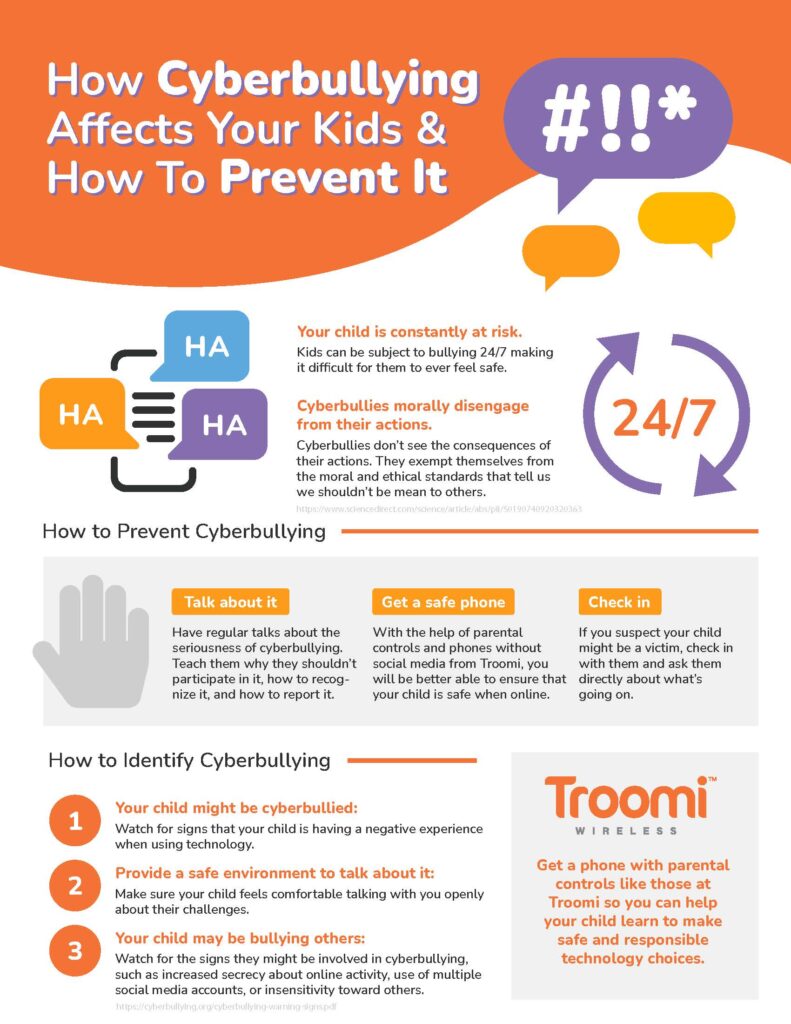
Most people associate bullying with the classic high school scene from a TV show: jocks steal some kid’s lunch money, the school nerd is hung by their underwear in the gym locker room—you know the routine.
This kind of bullying, although it still exists, has taken a backseat to a much more harmful and much less conspicuous form of bullying: cyberbullying.
What is Cyberbullying?
Cyberbullying is becoming more and more common and it’s hard to track just how many people are cyber bullied. The reality is that cyberbullying happens in many different ways—some of which might not even be recognized by your child as bullying. Here are a few ways your child might encounter cyberbullying:
- They receive cruel anonymous texts
- Rude comments are posted on their social media posts
- A fake account is made to impersonate them
- A mean social media or blog post indirectly references them
- They keep being reported to social media platforms with the intent of getting them banned
- Photos or videos of them are taken and shared without their permission
Why is Cyberbullying so Serious?
Believe it or not, cyberbullying is more harmful than bullying that happens in-person. But what makes cyberbullying different from regular bullying?
No Safe Zone
Typically in face-to-face bullying, there is somewhere the victim can go where they feel safe. It might be a certain classroom or their home. Cyberbullying, on the other hand, offers no such refuge. Victims of cyberbullying are constantly at risk. They live with a perpetual fear that as soon as they pick up their phone or log into their computer, there will be another message or comment from their attacker.
Posts Are Permanent
Once something is out on the Internet, there’s no deleting or hiding it. Even if a post is taken down, there is still a record of it somewhere. There’s no telling how many people have seen or shared a mean post or a text, and there’s no stopping the sharing once it’s started. Unfortunately, this means that an embarrassing photo or video of your child could resurface years after it was shared, causing even more damage than it initially did.
Bullies Are Anonymous
When someone is bullied face-to-face, there’s no hiding the identity of the bully. Cyberbullies, however, never have to reveal who they really are. This not only makes it easier for them to be mean, but it also prevents the victim from ever feeling safe at school or with friends. Their attacker could literally be anyone. Because of this, victims are much less trusting—even of those they love—and thus refrain from seeking help from anyone.
Warning Signs of Cyberbullying
You might be surprised at how many people are cyberbullied. Studies show that nearly 37% of young people have been cyberbullied in their lifetime. That’s over one-third of young people. And unfortunately, your child could likewise fall victim.
But if your child won’t tell you that they are being cyberbullied (whether it be out of fear or shame) how will you know how or when to help them?
Here are some warning signs to watch for in your child:
- They are nervous when using technology
- They are reluctant to use technology
- They seem angry, sad, or frustrated after using technology
- Their eating habits change
- They begin making comments about suicide or the triviality of life
- They seem more withdrawn from friends and family than usual
- They are reluctant to go to school or out with friends
- They are unwilling to talk about their online activities
How to Help A Child Who is Being Cyberbullied
If your child is exhibiting signs of being cyberbullied, talk with them about it. Help them understand that they shouldn’t feel ashamed or afraid of speaking about their experiences and feelings. Most importantly, help them understand their worth and that whatever has been said by the bully(ies) is false and has no reflection on who your child is. If necessary, seek professional guidance from a counselor to help them overcome the harmful effects of their experiences.
If you are able to find out the identity of the cyberbully, look into your state’s cyberbullying law to see what legal action should be taken to help prevent the bully from causing further damage to your child or anyone else. And be sure your child is aware of the cyberbullying law as well so they understand how serious cyberbullying is and why they shouldn’t participate in it.
To find out more about how you can prevent cyberbullying in your home, check out Troomi devices. Built-in parental controls allow you to stop unwanted numbers from contacting your children and limit access to harmful or addictive apps, making Troomi phones a safe and smart option for your child.

